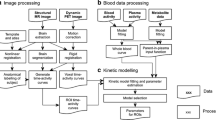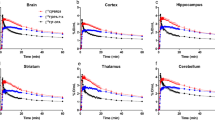Abstract
Purpose
Imaging of the 18-kDa translocator protein (TSPO) is a potential tool for examining microglial activation and neuroinflammation in early Alzheimer’s disease (AD). [18F]FEMPA is a novel high-affinity second-generation TSPO radioligand that has displayed suitable pharmacokinetic properties in preclinical studies. The aims of this study were to quantify the binding of [18F]FEMPA to TSPO in AD patients and controls and to investigate whether higher [18F]FEMPA binding in AD patients than in controls could be detected in vivo.
Methods
Ten AD patients (five men, five women; age 66.9 ± 7.3 years; MMSE score 25.5 ± 2.5) and seven controls (three men, four women; age 63.7 ± 7.2 years, MMSE score 29.3 ± 1.0) were studied using [18F]FEMPA at Turku (13 subjects) and at Karolinska Institutet (4 subjects). The in vitro binding affinity for TSPO was assessed using PBR28 in a competition assay with [3H]PK11195 in seven controls and eight AD patients. Cortical and subcortical regions of interest were examined. Quantification was performed using a two-tissue compartment model (2TCM) and Logan graphical analysis (GA). The outcome measure was the total distribution volume (V T). Repeated measures analysis of variance was used to assess the effect of group and TSPO binding status on V T.
Results
Five AD patients and four controls were high-affinity binders (HABs). Three AD patients and three controls were mixed-affinity binders. V T estimated with Logan GA was significantly correlated with V T estimated with the 2TCM in both controls (r = 0.97) and AD patients (r = 0.98) and was selected for the final analysis. Significantly higher V T was found in the medial temporal cortex in AD patients than in controls (p = 0.044) if the TSPO binding status was entered as a covariate. If only HABs were included, significantly higher V T was found in the medial and lateral temporal cortex, posterior cingulate, caudate, putamen, thalamus and cerebellum in AD patients than in controls (p < 0.05).
Conclusion
[18F]FEMPA seems to be a suitable radioligand for detecting increased TSPO binding in AD patients if their binding status is taken into account.





Similar content being viewed by others
References
Wyss-Coray T, Rogers J. Inflammation in Alzheimer disease – a brief review of the basic science and clinical literature. Cold Spring Harb Perspect Med. 2012;2:a006346.
Rupprecht R, Papadopoulos V, Rammes G, Baghai TC, Fan J, Akula N, et al. Translocator protein (18 kDa) (TSPO) as a therapeutic target for neurological and psychiatric disorders. Nat Rev Drug Discov. 2010;9:971–88.
Scarf AM, Kassiou M. The translocator protein. J Nucl Med. 2011;52:677–80.
Bird JL, Izquierdo-Garcia D, Davies JR, Rudd JH, Probst KC, Figg N, et al. Evaluation of translocator protein quantification as a tool for characterising macrophage burden in human carotid atherosclerosis. Atherosclerosis. 2010;210:388–91.
Cosenza-Nashat M, Zhao ML, Suh HS, Morgan J, Natividad R, Morgello S, et al. Expression of the translocator protein of 18 kDa by microglia, macrophages and astrocytes based on immunohistochemical localization in abnormal human brain. Neuropathol Appl Neurobiol. 2009;35:306–28.
Kuhlmann AC, Guilarte TR. Cellular and subcellular localization of peripheral benzodiazepine receptors after trimethyltin neurotoxicity. J Neurochem. 2000;74:1694–704.
Venneti S, Lopresti BJ, Wiley CA. Molecular imaging of microglia/macrophages in the brain. Glia. 2013;61:10–23.
Cagnin A, Brooks DJ, Kennedy AM, Gunn RN, Myers R, Turkheimer FE, et al. In-vivo measurement of activated microglia in dementia. Lancet. 2001;358:461–7.
Edison P, Archer HA, Gerhard A, Hinz R, Pavese N, Turkheimer FE, et al. Microglia, amyloid, and cognition in Alzheimer’s disease: an [11C](R)PK11195-PET and [11C]PIB-PET study. Neurobiol Dis. 2008;32:412–9.
Wiley CA, Lopresti BJ, Venneti S, Price J, Klunk WE, DeKosky ST, et al. Carbon 11-labeled Pittsburgh compound B and carbon 11-labeled (R)-PK11195 positron emission tomographic imaging in Alzheimer disease. Arch Neurol. 2009;66:60–7.
Schuitemaker A, Kropholler MA, Boellaard R, van der Flier WM, Kloet RW, van der Doef TF, et al. Microglial activation in Alzheimer’s disease: an (R)-[11C]PK11195 positron emission tomography study. Neurobiol Aging. 2013;34:128–36.
Dolle F, Luus C, Reynolds A, Kassiou M. Radiolabelled molecules for imaging the translocator protein (18 kDa) using positron emission tomography. Curr Med Chem. 2009;16:2899–923.
Yasuno F, Ota M, Kosaka J, Ito H, Higuchi M, Doronbekov TK, et al. Increased binding of peripheral benzodiazepine receptor in Alzheimer’s disease measured by positron emission tomography with [11C]DAA1106. Biol Psychiatry. 2008;64:835–41.
Yasuno F, Kosaka J, Ota M, Higuchi M, Ito H, Fujimura Y, et al. Increased binding of peripheral benzodiazepine receptor in mild cognitive impairment-dementia converters measured by positron emission tomography with [11C]DAA1106. Psychiatry Res. 2012;203:67–74.
Varrone A, Mattsson P, Forsberg A, Takano A, Nag S, Gulyas B, et al. In vivo imaging of the 18-kDa translocator protein (TSPO) with [18F]FEDAA1106 and PET does not show increased binding in Alzheimer’s disease patients. Eur J Nucl Med Mol Imaging. 2013;40:921–31.
Owen DR, Howell OW, Tang SP, Wells LA, Bennacef I, Bergstrom M, et al. Two binding sites for [3H]PBR28 in human brain: implications for TSPO PET imaging of neuroinflammation. J Cereb Blood Flow Metab. 2010;30:1608–18.
Owen DR, Gunn RN, Rabiner EA, Bennacef I, Fujita M, Kreisl WC, et al. Mixed-affinity binding in humans with 18-kDa translocator protein ligands. J Nucl Med. 2011;52:24–32.
Owen DR, Yeo AJ, Gunn RN, Song K, Wadsworth G, Lewis A, et al. An 18-kDa translocator protein (TSPO) polymorphism explains differences in binding affinity of the PET radioligand PBR28. J Cereb Blood Flow Metab. 2012;32:1–5.
Kreisl WC, Lyoo CH, McGwier M, Snow J, Jenko KJ, Kimura N, et al. In vivo radioligand binding to translocator protein correlates with severity of Alzheimer’s disease. Brain. 2013;136:2228–38.
McKhann GM, Knopman DS, Chertkow H, Hyman BT, Jack CR Jr, Kawas CH, et al. The diagnosis of dementia due to Alzheimer's disease: recommendations from the National Institute on Aging-Alzheimer’s Association workgroups on diagnostic guidelines for Alzheimer’s disease. Alzheimers Dement. 2011;7:263–9.
Wahlund LO, Barkhof F, Fazekas F, Bronge L, Augustin M, Sjogren M, et al. A new rating scale for age-related white matter changes applicable to MRI and CT. Stroke. 2001;32:1318–22.
Kreisl WC, Jenko KJ, Hines CS, Lyoo CH, Corona W, Morse CL, et al. A genetic polymorphism for translocator protein 18 kDa affects both in vitro and in vivo radioligand binding in human brain to this putative biomarker of neuroinflammation. J Cereb Blood Flow Metab. 2013;33:53–8.
Owen DR, Guo Q, Kalk NJ, Colasanti A, Kalogiannopoulou D, Dimber R, et al. Determination of [11C]PBR28 binding potential in vivo: a first human TSPO blocking study. J Cereb Blood Flow Metab. 2014;34:989–94.
Acknowledgments
This study was sponsored by Bayer Healthcare, Berlin, Germany. The work at Turku PET Centre and Karolinska Institutet was supported by the European Union’s Seventh Framework Programme (FP7/2007-2013) under grant agreement HEALTH-F2-2011-278850 (INMIND). The compound [18F]FEMPA is now part of the portfolio of the Piramal Imaging GmbH, Berlin, Germany. The authors thank the staff of the Turku PET Centre, the Karolinska Institutet PET Centre and the Karolinska University Hospital for technical support.
Conflicts of interest
Ray Valencia, Marcus Schultze-Mosgau, Andrea Thiele, Sonja Vollmer, Thomas Dyrks, Lutz Lehmann, Tobias Heinrich, Anja Hoffmann were employed by Bayer Healthcare, Berlin, Germany at the time of the study.
Financial support
Bayer Healthcare, Berlin, Germany; FP7/2007-2013 HEALTH-F2-2011-278850 (INMIND).
Author information
Authors and Affiliations
Corresponding author
Additional information
Andrea Varrone and Vesa Oikonen contributed equally to this work.
Electronic supplementary material
Rights and permissions
About this article
Cite this article
Varrone, A., Oikonen, V., Forsberg, A. et al. Positron emission tomography imaging of the 18-kDa translocator protein (TSPO) with [18F]FEMPA in Alzheimer’s disease patients and control subjects. Eur J Nucl Med Mol Imaging 42, 438–446 (2015). https://doi.org/10.1007/s00259-014-2955-8
Received:
Accepted:
Published:
Issue Date:
DOI: https://doi.org/10.1007/s00259-014-2955-8




